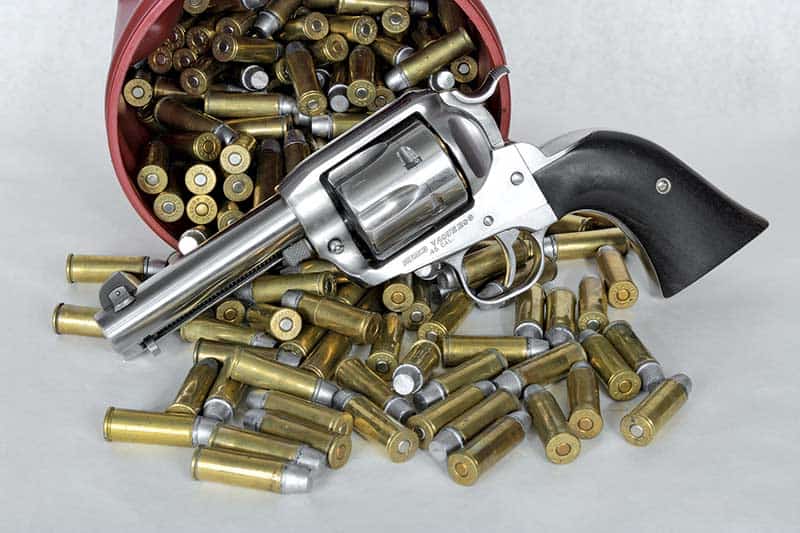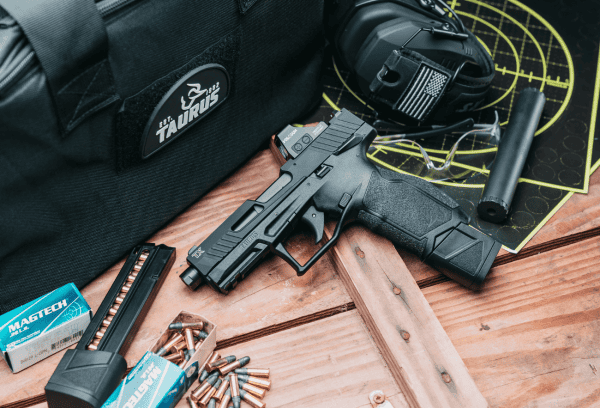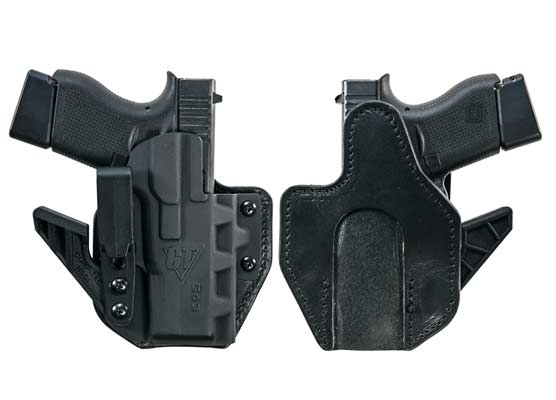Pragmatic Anachronism
Why Everyone Should Shoot the Big Bore Sixgun
The first reason — the stagecoach in the room, if you will — is the nostalgia and the coolness factor. Even if you didn’t grow up marveling at John Wayne’s 32-shot single action as I did, the Colt Peacemaker is the definitive American Gun. It’s the scion of the first gunfighter’s gun, the Wild-Bill-approved ’51 Navy Colt that went into the California gold fields with the Forty-niners and was used by Texas when it fought for independence from Mexico. Not to mention the brutal Walker .44, the first big-bore black powder Colt, produced after the Texas Rangers dispatched one Samuel Hamilton Walker to Connecticut to find the bankrupt Sam Colt and lure him back into the gun business.
All that foolishness of loose powder and balls and pig fat went away in 1873 when the new Single Action Army appeared with its self-contained .45 Colt cartridge that shoved a 250-grain bullet out the barrel around 900 feet per second. This was adequate for the cavalry to flatten an opponent’s horse in the mounted fights then raging between it and the Apache, Comanche and others.
It’s the definitive cowboy gun, both on screen and in the holsters of cowboy action shooters, and maintained its cachet as a fighting man’s gun when it rode across Europe on Patton’s hip in World War II. That wasn’t mere foppery: During 1916’s Punitive Expedition into Mexico, GSP flattened two o
Single-Action Utility?
This brings us to another obvious point: it’s not a good choice for concealed carry. The manual actuation required for each shot, slow reloading, and the need to use both hands drop it far down the list of good EDCs. I’ve been coached on single action at Gunsite under the capable tutelage of Lew Gosnell, winner of the inaugural End of Trail cowboy action shoot, and consider myself somewhat competent. But while a skilled man could get through the night with one if pressed, it is not a first choice for anyone who isn’t Bob Munden.
Where it does surpass expectations is in the field and as a training tool. Semiauto mechanisms are designed to function by a certain amount of force, which means there is a limited window of ammo that will work reliably. Too hot, or too weak, and your pistol is a repeater. Not so the single action: If it can get the projectile out of the bore and operate at a pressure that doesn’t blow primer parts back into the action to tie it up, the gun’s pretty much gonna work. Shot cartridges? Check. That original cavalry-level .45 Colt load of 250 at 900? Sure, plus light loads for more tender shooters that send 160s trundling down the barrel at a mild 600-700 fps. If you spend time in bear country, heavy .45 Colt loads can launch a 335-grain slug up to 1,200 fps, which should be plenty of excitement for both your wrist and the bear.
Managing Power
I’ve spent my time with the .45 Colt, but the .44 Magnum/Special has an equal breadth of power levels. Of course, there are calibers that are still more potent, but most of us can’t manage those with the dexterity required to make them practical for predator defense. If you can, you probably know all this already; feel free to keep reading, but I don’t want to waste your time. For everything from snakes to smallish, large, and most dangerous game, the .44 and .45s can get it done, and the good single actions are all plenty accurate enough if used responsibly.
Those whose feet pound only pavement are not off the hook. No matter what you carry, you will be a better shooter if you learn to manage the big bore sixgun well. It will absolutely school you on recoil control and grip consistency.
Managing recoil is not an inborn skill: There’s nothing natural about an explosion going off arm’s length from your face. Knowing what’s about to happen when you press the trigger fights against your lizard-brain desire for self-preservation, often manifesting itself in a sharp jerk of the trigger and accompanying miss. The more recoil, the more difficult it is to focus on the sights and breaking the trigger cleanly, but developing a heightened ability to focus on those two fundamentals only makes you better across the board. More bluntly, if you can manage the blast and kick of a full-power .44 Magnum, the 9mm will seem far less of a challenge to run at speed.
And we’re not talking about super-fast sixgun work: I mean just being able to hit the target, which is not a given. Consider it a subclass of “train hard, fight easy.” Shooting the powerful African express rifles offers a similar training opportunity because your mind has to overcome the accumulated dread of every fiber of your being toward the walnut pile driver you’re about to punch into your deltoid. The bloody sting offered by long-hammered pre-A1 1911s provides a similar challenge to overcome, but not one I like to take in large doses.
Single-Action Recoil
And the big bores do recoil. Not only do they have more power — even the middle-of-the-road .45 Colt develops significantly more thump than the common semi-auto rounds — but there’s no reciprocating slide to absorb recoil energy. You get it all. And this difference in how the mechanism affects recoil is why we’re talking specifically about single-action big bores instead of double-action.
No doubt, a double action .44 will kick as unpleasantly as a single action one, but it kicks in a different way. This has nothing to do with the trigger per se, although the double-action trigger is harder to master, as evidenced by how the once-popular DA auto pistol has inexorably yielded its ground to striker-fired pistols. The difference is in grip shape.
I just finished reading a Skeeter Skelton article from a few decades ago where he listed detailed notes he’d gotten from pioneering stockmaker Steve Herrett. In them, Herrett described how part of the genius of the single action frame shape was where it located the gun’s pivot point in recoil. Of course, he’s right — because of the smooth curvature of the grip strap (there’s no hump at the top, as with a DA) and the thick-to-thin shape of the handle, a single action moves through your hand as it recoils. This is why the saw handle-like Bisley grip, which does not rotate, is used exclusively on the truly massive sixgun calibers. Otherwise, they’d bury the hammer spur in the web of your hand with every shot.
Even more importantly, the gun begins to recoil while the bullet is still in the barrel. If you’ve ever noticed how tall some revolver sights are, the barrel is actually pointing below the line of sight and the bullet is exiting the barrel as the muzzle rises. A moment’s thought shows how delicate a balance this creates: Grip the gun too hard, and the shot goes low. Too loose, and it hits high. Grip it too much on one side, and the gun tries to escape toward the open side of your hand. A single action will absolutely school you on grip consistency. There’s no way to cheat like you can a bit on a semi-auto, which generally has a more clearly defined location for hand placement. What you see is what you’ve done. Do it more, do it better, and apply that newfound consistency to the other platforms you shoot.
And don’t start with the hottest stuff. I’ve seen a novice shooter handle a big bore’s recoil so badly that his poor grip turned the gun into an inertial bullet puller, making one of the big slugs jump its crimp, and there’s been at least one death from a shooter being struck in the head by the recoiling barrel of a heavy caliber revolver. If that’s what you want, the skill will arrive in time. For 255 grains at 900 fps, from either a .44 or .45, is a good enough schoolmaster.
For more info: BowenClassicArms.com, Black-Hills.com, DoubleTapAmmo.com, GrizzlyCartridge.com, Gunsite.com, Ruger.com












